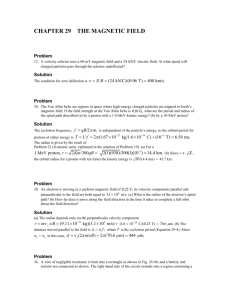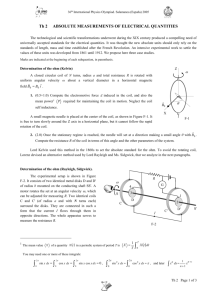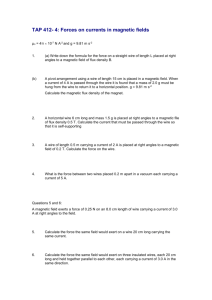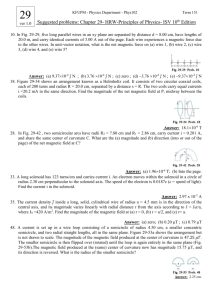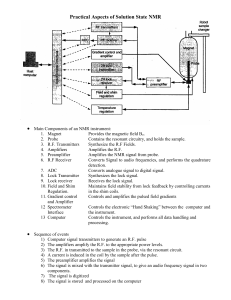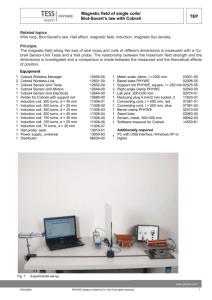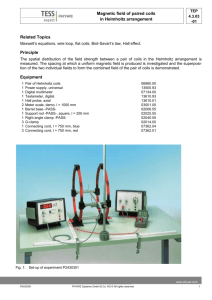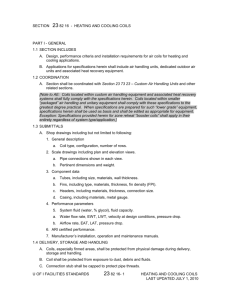Magnetic Fields from Currentsv2
advertisement
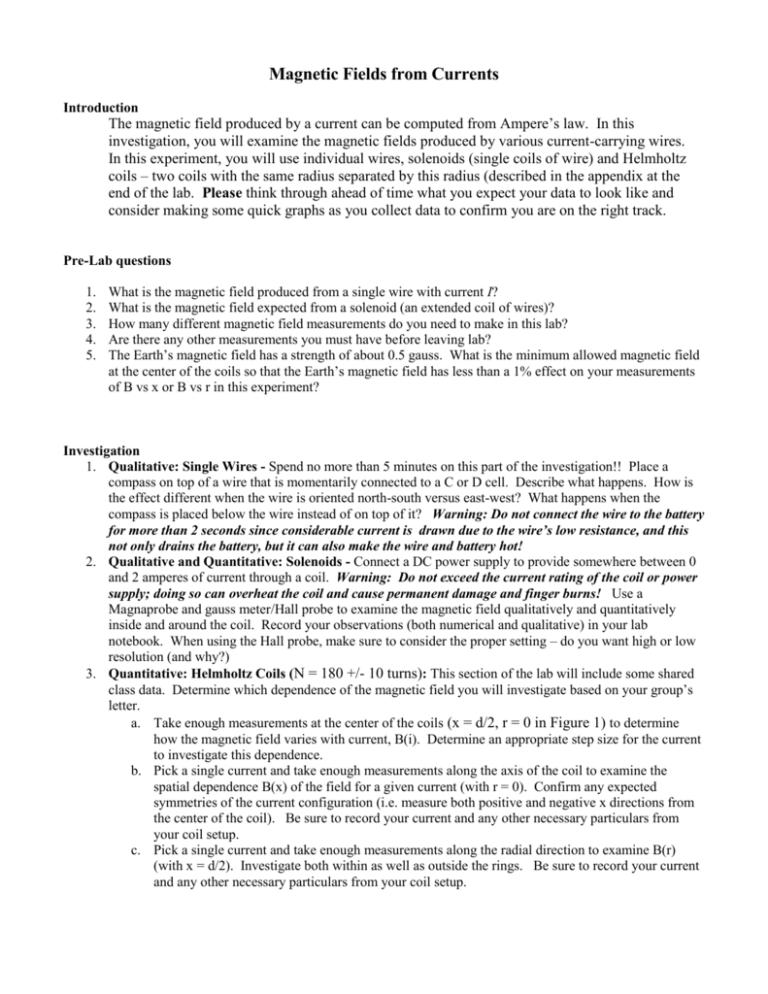
Magnetic Fields from Currents Introduction The magnetic field produced by a current can be computed from Ampere’s law. In this investigation, you will examine the magnetic fields produced by various current-carrying wires. In this experiment, you will use individual wires, solenoids (single coils of wire) and Helmholtz coils – two coils with the same radius separated by this radius (described in the appendix at the end of the lab. Please think through ahead of time what you expect your data to look like and consider making some quick graphs as you collect data to confirm you are on the right track. Pre-Lab questions 1. 2. 3. 4. 5. What is the magnetic field produced from a single wire with current I? What is the magnetic field expected from a solenoid (an extended coil of wires)? How many different magnetic field measurements do you need to make in this lab? Are there any other measurements you must have before leaving lab? The Earth’s magnetic field has a strength of about 0.5 gauss. What is the minimum allowed magnetic field at the center of the coils so that the Earth’s magnetic field has less than a 1% effect on your measurements of B vs x or B vs r in this experiment? Investigation 1. Qualitative: Single Wires - Spend no more than 5 minutes on this part of the investigation!! Place a compass on top of a wire that is momentarily connected to a C or D cell. Describe what happens. How is the effect different when the wire is oriented north-south versus east-west? What happens when the compass is placed below the wire instead of on top of it? Warning: Do not connect the wire to the battery for more than 2 seconds since considerable current is drawn due to the wire’s low resistance, and this not only drains the battery, but it can also make the wire and battery hot! 2. Qualitative and Quantitative: Solenoids - Connect a DC power supply to provide somewhere between 0 and 2 amperes of current through a coil. Warning: Do not exceed the current rating of the coil or power supply; doing so can overheat the coil and cause permanent damage and finger burns! Use a Magnaprobe and gauss meter/Hall probe to examine the magnetic field qualitatively and quantitatively inside and around the coil. Record your observations (both numerical and qualitative) in your lab notebook. When using the Hall probe, make sure to consider the proper setting – do you want high or low resolution (and why?) 3. Quantitative: Helmholtz Coils (N = 180 +/- 10 turns): This section of the lab will include some shared class data. Determine which dependence of the magnetic field you will investigate based on your group’s letter. a. Take enough measurements at the center of the coils (x = d/2, r = 0 in Figure 1) to determine how the magnetic field varies with current, B(i). Determine an appropriate step size for the current to investigate this dependence. b. Pick a single current and take enough measurements along the axis of the coil to examine the spatial dependence B(x) of the field for a given current (with r = 0). Confirm any expected symmetries of the current configuration (i.e. measure both positive and negative x directions from the center of the coil). Be sure to record your current and any other necessary particulars from your coil setup. c. Pick a single current and take enough measurements along the radial direction to examine B(r) (with x = d/2). Investigate both within as well as outside the rings. Be sure to record your current and any other necessary particulars from your coil setup. Analysis Prepare plots of B vs I, B vs. x and B vs. r for the Helmholtz coil data. What are the expected dependences for these relationships? Are any of these appropriate to fit with a linear fit? If not, why and how can we tell if the data matches our expectations? If so, do the fits and identify the parameters of your fit. Qualitatively examine the plots you chose not to fit. Do they match your expectations for two closely spaced circular loops? **An Important Note on Units The SI unit for magnetic fields is the tesla (abbreviated T), where 1 T = 1 N/A•m. Another common unit is the gauss, where 1 T = 10 4 gauss. Gauss are convenient units for taking measurements in this experiment, as the fields generated are quite small. However, any equations containing B in this write-up require B to be in units of tesla. Discussion Summarize your findings in your second (and final) individual full lab report. Be sure to include thoughts on the uses of magnetic fields and the general applications of this kind of setup as well as what the largest sources of error are in your experiment. The equation you derived for the magnetic field created by a pair of coils is difficult to examine using analytic methods. Therefore, you will once again use a MATLAB program to simulate your experiment and answer some questions. Please visit http://physics.unc.edu/undergraduateprogram/labs/physics-117/ for another MATLAB code. Open the file, run the code, and explain briefly what it is showing you. Appendix – Theory on the Magnetic Field of a Coaxial Coil Pair Current-carrying coils of wire can be used to produce large uniform magnetic fields. One arrangement consists of two circular coaxial coils of wire each having N turns and radius R separated by distance d as shown in Figure 1. The magnetic field along the x-axis of the coil combination (r = 0, see Figure 1) is given by the expression: B(x) o NIR 2 2 1 1 2 2 32 ( R 2 ( d x) 2 ) 3 2 (R x ) (1) When the separation between the coils is equal to the radius (d = r), the arrangement is called a Helmholtz coil pair. This coil configuration provides a magnetic field between the two coils that is fairly uniform in both the radial and axial directions. The r strength and uniformity of the field between the coils can be measured using a device called a Hall probe. This device measures the potential difference generated between sides of the probe R when moving charge carriers are deflected to the side by the magnetic field under study. The size of x the potential difference generated in the probe is proportional to B. x=d/2 I I x=0 d Figure 1 x=d
